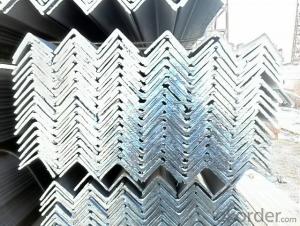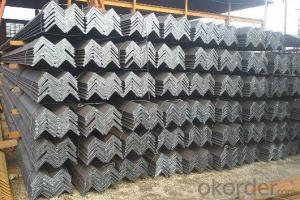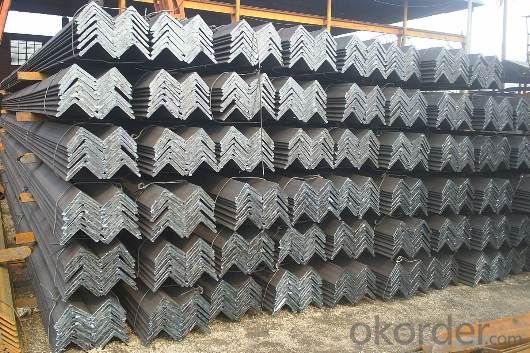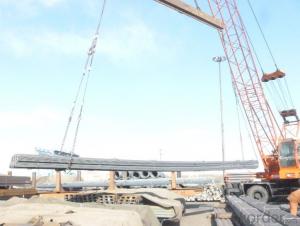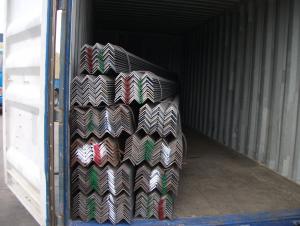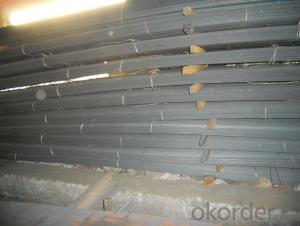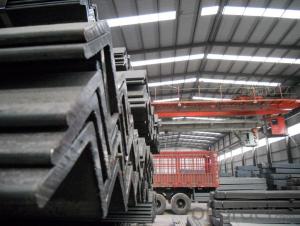Hot Rolled Equal Angles with High Quality
- Loading Port:
- Tianjin
- Payment Terms:
- TT OR LC
- Min Order Qty:
- 25 m.t.
- Supply Capability:
- 20000 m.t./month
OKorder Service Pledge
OKorder Financial Service
You Might Also Like
Product Description:
OKorder is offering Hot Rolled Equal Angles at great prices with worldwide shipping. Our supplier is a world-class manufacturer of steel, with our products utilized the world over. OKorder annually supplies products to European, North American and Asian markets. We provide quotations within 24 hours of receiving an inquiry and guarantee competitive prices.
Product Applications:
Hot Rolled Equal Angles are ideal for structural applications and are widely used in the construction of buildings and bridges, and the manufacturing, petrochemical, and transportation industries.
Product Advantages:
OKorder's Hot Rolled Equal Angles are durable, strong, and resist corrosion.
Main Product Features:
· Premium quality
· Prompt delivery & seaworthy packing (30 days after receiving deposit)
· Corrosion resistance
· Can be recycled and reused
· Mill test certification
· Professional Service
· Competitive pricing
Product Specifications:
Manufacture: Hot rolled
Grade: Q195 – 235
Certificates: ISO, SGS, BV, CIQ
Length: 6m – 12m, as per customer request
Packaging: Export packing, nude packing, bundled
Sizes: 25mm-250mm | ||
a*t | ||
25*2.5-4.0 | 70*6.0-9.0 | 130*9.0-15 |
30*2.5-6.6 | 75*6.0-9.0 | 140*10-14 |
36*3.0-5.0 | 80*5.0-10 | 150*10-20 |
38*2.3-6.0 | 90*7.0-10 | 160*10-16 |
40*3.0-5.0 | 100*6.0-12 | 175*12-15 |
45*4.0-6.0 | 110*8.0-10 | 180*12-18 |
50*4.0-6.0 | 120*6.0-15 | 200*14-25 |
60*4.0-8.0 | 125*8.0-14 | 250*25 |
FAQ:
Q1: Why buy Materials & Equipment from OKorder.com?
A1: All products offered byOKorder.com are carefully selected from China's most reliable manufacturing enterprises. Through its ISO certifications, OKorder.com adheres to the highest standards and a commitment to supply chain safety and customer satisfaction.
Q2: What makes stainless steel stainless?
A2: Stainless steel must contain at least 10.5 % chromium. It is this element that reacts with the oxygen in the air to form a complex chrome-oxide surface layer that is invisible but strong enough to prevent further oxygen from "staining" (rusting) the surface. Higher levels of chromium and the addition of other alloying elements such as nickel and molybdenum enhance this surface layer and improve the corrosion resistance of the stainless material.
Q3: Can stainless steel rust?
A3: Stainless does not "rust" as you think of regular steel rusting with a red oxide on the surface that flakes off. If you see red rust it is probably due to some iron particles that have contaminated the surface of the stainless steel and it is these iron particles that are rusting. Look at the source of the rusting and see if you can remove it from the surface.
Images:
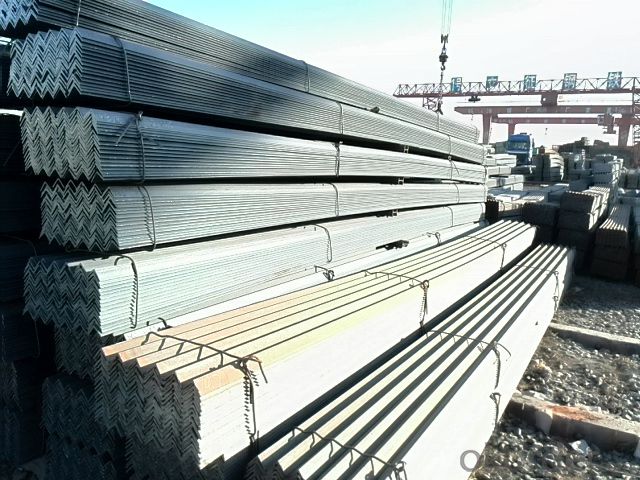
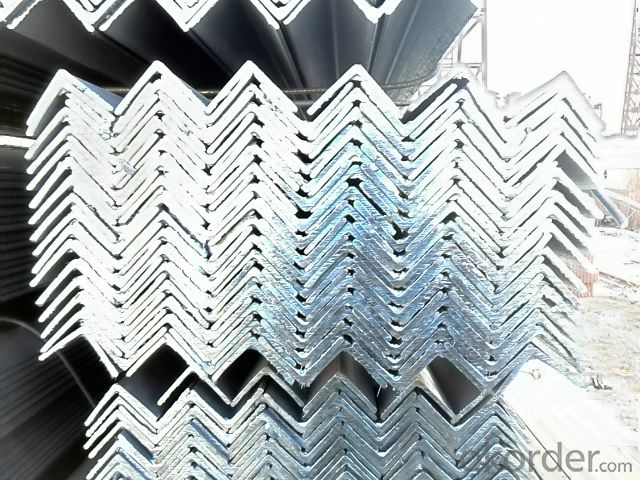
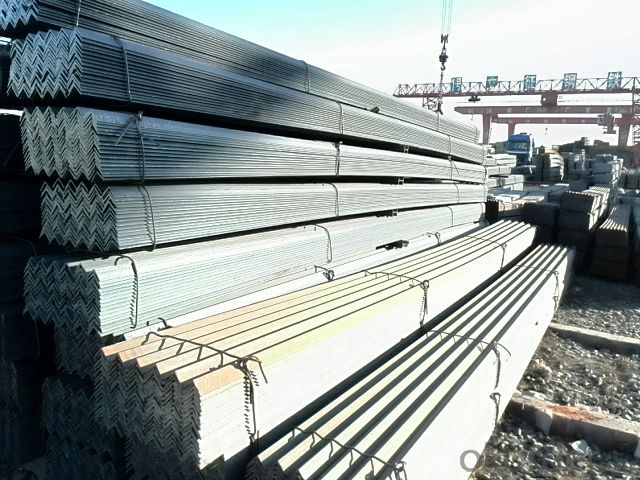
- Q: Can steel angles be used in playground equipment?
- Indeed, playground equipment can indeed incorporate steel angles. Steel angles find frequent application within the construction sector owing to their robustness, longevity, and adaptability. They can effectively offer structural reinforcement and steadiness to diverse play structures, including slides, climbing apparatus, swings, and playsets. By welding or bolting steel angles together, a resilient framework can be fashioned, capable of withstanding the dynamic loads exerted by playing children. Furthermore, these steel angles can be coated or painted to ensure resistance against corrosion, while simultaneously augmenting the visual allure of the playground equipment.
- Q: What are the different methods for cutting steel angles?
- There are several different methods for cutting steel angles, depending on the specific requirements and the tools available. Some of the most common methods include: 1. Manual cutting: This involves using a handheld hacksaw or a metal cutting bandsaw to cut through the steel angle. It is a labor-intensive method and may not be suitable for large-scale projects or precise cuts. 2. Abrasive cutting: This method uses an abrasive wheel or disc to grind through the steel angle. It is commonly done with an angle grinder or a chop saw. Abrasive cutting is faster than manual cutting and can provide reasonably accurate cuts. 3. Plasma cutting: Plasma cutting involves using a high-temperature plasma arc to melt through the steel angle. It is a versatile method that can cut through thick steel angles quickly and accurately. However, it requires specialized equipment and may not be suitable for small-scale or on-site projects. 4. Laser cutting: Laser cutting uses a high-powered laser beam to melt through the steel angle. It is a precise and efficient method that can produce intricate cuts with minimal heat-affected zones. Laser cutting is commonly used in industrial settings and requires specialized equipment. 5. Waterjet cutting: Waterjet cutting utilizes a high-pressure jet of water mixed with abrasive particles to cut through the steel angle. It is a versatile method that can produce precise cuts without generating heat or causing distortion. Waterjet cutting is commonly used in industries where heat-affected zones and material distortion are a concern. 6. Shearing: Shearing involves using a shear machine to apply a cutting force to the steel angle, causing it to fracture along a predetermined line. It is a fast and efficient method for straight cuts and is commonly used for high-volume production. The choice of cutting method depends on various factors such as the size and thickness of the steel angle, the desired accuracy of the cut, the available equipment, and the project requirements. It is important to consider the specific needs and limitations before selecting the most appropriate cutting method.
- Q: Can steel angles be used in agricultural buildings?
- Yes, steel angles can be used in agricultural buildings. Steel angles, also known as angle iron, are commonly used in construction due to their strength and versatility. In agricultural buildings, steel angles can be utilized for various purposes such as framing, bracing, and supporting the structure. They can be used to create sturdy frames for walls, roof trusses, and other structural elements. Steel angles also provide excellent load-bearing capacity, making them suitable for supporting heavy equipment or machinery commonly found in agricultural buildings. Moreover, steel angles are resistant to corrosion, which is essential in agricultural environments where exposure to moisture and various chemicals is common. Overall, steel angles are a practical and reliable choice for agricultural buildings due to their strength, durability, and resistance to environmental factors.
- Q: How do steel angles perform under dynamic or cyclic loading conditions?
- Steel angles are widely used in structural applications, where they are exposed to dynamic or cyclic loading conditions. These conditions allow the angles to demonstrate their excellent performance due to their inherent properties. First and foremost, steel angles possess remarkable strength and stiffness, enabling them to withstand varying loads and maintain their structural integrity. This ensures that the angles do not deform or fail prematurely when subjected to cyclic loading conditions. Moreover, steel angles exhibit excellent fatigue resistance, meaning they can endure repeated loading and unloading cycles without suffering significant degradation in their mechanical properties. This is possible because the material has the ability to distribute and dissipate stress, preventing the accumulation of fatigue damage. Furthermore, steel angles have the advantage of effectively absorbing and distributing energy. This characteristic aids in reducing the impact of dynamic loads, such as vibrations or sudden impacts, and prevents the formation of localized stress concentrations that could lead to failure. Additionally, steel angles possess high ductility, allowing them to undergo plastic deformation without fracturing. This characteristic is crucial in dynamic loading conditions as it enables the angles to absorb energy and undergo deformation, thereby dissipating the applied loads and reducing the risk of sudden failure. To conclude, steel angles exhibit exceptional performance under dynamic or cyclic loading conditions. Their high strength, stiffness, fatigue resistance, energy absorption capacity, and ductility make them reliable and durable structural elements in various applications where they are subjected to dynamic or cyclic loads.
- Q: What are the common methods of surface preparation for steel angles?
- Steel angles can be prepared for surface treatment through various methods, including grinding, sandblasting, and chemical cleaning. Grinding is a mechanical technique that involves using an abrasive wheel or disc to smooth and level the surface of the steel angle. This method effectively eliminates rust, scale, and other imperfections. It is commonly used for small-scale projects or when achieving a smooth surface finish is not crucial. Sandblasting, also referred to as abrasive blasting, entails propelling small particles onto the surface of the steel angle at high speeds. This method is highly efficient in removing mill scale, rust, paint, and other contaminants. Sandblasting creates a textured surface that enhances the adhesion of coatings or paints. It is often employed in large-scale industrial projects that require a high-quality surface finish. Chemical cleaning involves the use of chemical solutions to eliminate contaminants from the surface of the steel angle. This method effectively removes rust, oil, grease, and other organic materials. Chemical cleaning can be carried out using various techniques, such as immersion or brush application. It is typically employed when sandblasting or grinding is not feasible or practical. Additionally, power tool cleaning, flame cleaning, or a combination of methods may be used for surface preparation, depending on the specific project requirements. It is crucial to select the appropriate method based on the condition of the steel angle, the desired surface finish, and the intended application of the steel angle.
- Q: What is the typical corrosion rate of galvanized steel angles?
- The corrosion rate of galvanized steel angles can vary depending on several factors, such as environmental conditions, exposure to corrosive agents, and the quality of the galvanized coating. However, galvanized steel angles are generally recognized for their excellent corrosion resistance properties. The zinc coating on the steel acts as a protective barrier, preventing the underlying steel from contacting corrosive elements like moisture and oxygen. Under normal atmospheric conditions, the corrosion rate of galvanized steel angles is approximately 1-5 microns per year. This rate can be further reduced in less aggressive environments or with the use of additional protective coatings or maintenance practices. Moreover, in dry or non-corrosive environments, galvanized steel angles can exhibit even lower corrosion rates. It should be noted that in more severe or highly corrosive environments, the corrosion rate of galvanized steel angles may accelerate. These environments may include high humidity, exposure to saltwater, acidic or alkaline conditions, or industrial atmospheres with high levels of pollutants. In such cases, it is advisable to seek advice from corrosion engineers or experts to determine the appropriate corrosion protection measures or alternative materials that may be more suitable for the specific application.
- Q: How do you join steel angles together?
- There are several methods to join steel angles together, depending on the specific requirements and circumstances. Here are some common techniques used: 1. Welding: Welding is a popular and effective method for joining steel angles. It involves melting the edges of the angles together and fusing them using a welding machine. Welding provides strong and durable connections, but it requires skilled personnel and proper safety precautions. 2. Bolting: Bolting is another common way to join steel angles. It involves using bolts, nuts, and washers to connect the angles together. This method provides a secure connection and allows for disassembly if needed. It is relatively straightforward and does not require specialized equipment. 3. Riveting: Riveting is a traditional method that involves using rivets to connect steel angles. It requires drilling holes in the angles and using a rivet gun to secure the rivets. This method provides a strong and permanent connection. 4. Adhesive bonding: Adhesive bonding involves using a strong adhesive to join steel angles together. This method is suitable for lightweight applications and offers the advantage of not requiring heat or specialized equipment. However, it may not be suitable for heavy-duty or high-stress applications. It is important to consider factors such as the load-bearing capacity, structural integrity, aesthetic requirements, and environmental conditions when selecting the appropriate method for joining steel angles together. Additionally, consulting with a professional engineer or fabricator can help ensure the most suitable joining method is chosen for your specific needs.
- Q: What are the different types of steel angles used in storage racks?
- There are several different types of steel angles that are commonly used in storage racks. These angles are specifically designed to provide strength and stability to the racks, allowing for efficient storage and organization of various items. 1) Equal Angle: This is the most commonly used type of steel angle in storage racks. It has equal sides and is often used as the main support beam in the structure of the rack. The equal angles provide balanced weight distribution and ensure stability. 2) Unequal Angle: As the name suggests, unequal angles have different lengths on each side. These angles are typically used in storage racks where specific weight distribution or load-bearing requirements need to be met. The longer side of the unequal angle provides additional support for heavier items or different storage configurations. 3) Slotted Angle: Slotted angles are versatile and allow for easy adjustment and customization of storage rack systems. They feature slots along the length of the angle, enabling the addition of shelves, dividers, or other accessories as needed. Slotted angles are often used in warehouses or industrial settings where frequent reconfiguration of the rack system is required. 4) Perforated Angle: Perforated angles have holes punctured along their length, providing better ventilation and visibility for stored items. These angles are commonly used in storage racks for items that may require airflow or for racks used in retail settings where product visibility is important. 5) Corner Angle: Corner angles are L-shaped steel angles used to reinforce and strengthen the corners of storage racks. They provide additional support and stability, preventing the rack from collapsing or tipping over when heavy items are stored on the shelves. Overall, the selection of the type of steel angle used in storage racks depends on the specific requirements of the rack system, including load-bearing capacity, customization options, ventilation needs, and visual appeal. By choosing the appropriate steel angle, storage racks can be optimized for maximum efficiency and durability.
- Q: How do you prevent welding distortion in steel angles?
- There are several ways to prevent welding distortion in steel angles. One common method is to use tack welds to hold the pieces in place before making the final welds. This helps to distribute the heat more evenly and reduce the chances of distortion. Additionally, using a smaller welding electrode or reducing the welding current can also help minimize distortion. Another technique is to weld in a staggered pattern, alternating between the top and bottom sides of the angle, which can help to balance the thermal effects. Lastly, controlling the preheating and cooling rates, as well as implementing proper welding sequence and clamping techniques, can further reduce welding distortion in steel angles.
- Q: How are steel angles used in framing?
- Framing utilizes steel angles for a variety of purposes. Structural support and stability are among the primary uses of steel angles in framing. They are combined with other building materials, such as wood or concrete, to create a strong and enduring frame. Building corners are commonly formed using steel angles in framing. These angles are often positioned at the intersections of walls and floors to reinforce the structure and prevent sagging or collapse. Additionally, steel angles secure and strengthen joints between beams, columns, and other structural elements. Apart from their structural function, steel angles offer versatility in framing. They can be easily cut, bent, and welded, enabling customization and adaptation to diverse construction requirements. Steel angles are employed to create braces, supports, and even decorative elements in the framing process. Furthermore, steel angles are renowned for their high strength and resistance to bending or warping. This makes them ideal for withstanding heavy loads and providing long-lasting support in a framing system. Their durability and reliability establish them as a preferred choice in numerous construction projects. In conclusion, steel angles are crucial in framing as they provide structural stability, reinforcement, and versatility. Their implementation ensures the strength and durability of buildings or structures, making them an essential component in the construction industry.
Send your message to us
Hot Rolled Equal Angles with High Quality
- Loading Port:
- Tianjin
- Payment Terms:
- TT OR LC
- Min Order Qty:
- 25 m.t.
- Supply Capability:
- 20000 m.t./month
OKorder Service Pledge
OKorder Financial Service
Similar products
Hot products
Hot Searches
Related keywords
